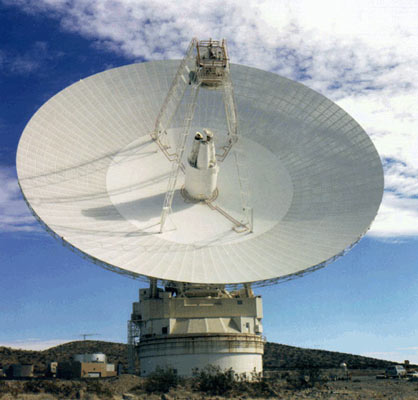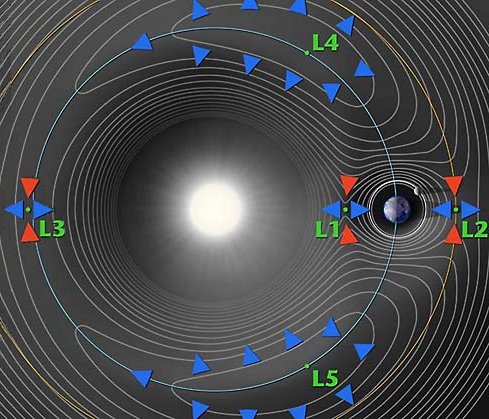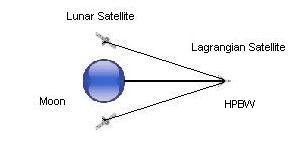Table of Contents
Home Page
System Overview
Link Budget
Communications Design
Cost Analysis
References
Source Code
|
|
System Specs
The LunarRadioTelescope system (LRT) was designed to
provide a high fidelity and high-speed connection t transmit data from a
relatively noise free environment from the dark side of the moon back to
earth. Knowing that the distance between the earth and the moon is
384,400km, the 8.16 GHz bandwidth is a testament to the vast amount of data
being transmitted through the network. Careful selection of the positioning
and orbits of the relay satellites to accomplish this task
were critical to the project. The details of the path taken and the
orbital parameters can be found on this page.

The Deep Space Network
The system will relay communication between the moon observatory and
Earth using the Deep Space Network (DSN). Because of its existing and
The DSN currently consists of three deep-space communications facilities
placed approximately 120 degrees apart around the world at:
|
 |
 | the Goldstone Deep Space
Communications Complex outside of Barstow, California, United
States; |
 | the Madrid Deep Space
Communication Complex, 60 kilometers west of Madrid, Spain; and |
 | the Canberra Deep Space
Communications Complex (CDSCC) in the Australian Capital Territory,
40 kilometers southwest of Canberra, Australia near the Tidbinbilla
Nature Reserve. |
 |
Each complex consists of at least four deep space stations equipped
with ultra-sensitive receiving systems and large parabolic dish antennas.
The one of particular interest for this application will be the
34-meter (111-ft) diameter High Efficiency antenna. With this network,
we will be able to accept signals from almost any incoming trajectory
with exception of the highly polar regions which are not of interest
here.
DSN coverage of the Southern Hemisphere is limited, in
spite of the Canberra complex. There are no DSN network dishes in South
America, nor any in Africa. If the network had full Southern Hemisphere
redundancy of its Northern Hemisphere assets, data loss events would
almost never occur. However, regarding of the minimal amount of losses
which can be accounted for by the DSN architecture, we have allowed for
additional link margin to account for this.
|

Satellite Configuration
The satellite configuration for the described satellite network will
include 2 relay satellites placed at conscientiously selected locations
in space to minimize path-loss factors and also provide a stable yet
simple path for RF communication. These dishes will have a diameter
of 5m and as such will need to be inflated/expanded when they arrive at
their location.
Specific research was done to realize stable stationary points which
could be feasible to place a satellite for purposes of the satellite
network. A simple lunarstationary orbit was initially considered, but
later discarded because the earth's gravitational force would cause the
satellite pull toward the larger mass and eventually crash into the
planet. Further investigation led to the discovery of existing stable
points given a two-body system called the Lagrangian points.
Lagrangian Points
| The Lagrangian points are the five positions in
interplanetary space where a small object affected only by gravity
can theoretically be stationary relative to two larger objects
(such as a satellite with respect to the Earth and Moon). The
Lagrange Points mark positions where the combined gravitational
pull of the two large masses provides precisely the centripetal
force required to rotate with them. They are analogous to
geosynchronous orbits in that they allow an object to be in a
"fixed" position in space rather than an orbit in which
its relative position changes continuously.
For
purposes of this satellite, we have chosen to use the location of
the Lagrangian point L2, a distance of 61558km away from the dark
side of the moon. While L4 and L5 are stable points relative to
the two-body system, L1, L2, and L3 are not relatively
stable. The situation can be compared to a ball resting at
the top of a hill, in which a slight push in one direction could
send the object away from its meta-stable point. This factor was
considered, and sufficient stationkeeping fuel and plans to use a
Lissajous orbit are in place to counteract this fact. |
 |
The second relay satellite will be placed in a polar lunar
orbit with an orbital altitude of 100km from the lunar surface and an
eccentricity and axis tilt of .1 and 2° from the polar axis respectively.
100km was the minimum distance which could sustain a stable orbit
without long-term degradation. This orbit benefits from the
fact that it is always in view of both the initial satellite feed and
the Earth, and it can therefore transmit data 100% of the time.
Additionally the half-power bandwidth of the first satellite does
contain the entire orbit of the lunar satellite so limited attitude
adjustment will have to be done at the first satellite.
 |
HPBW Needed=2*atan(Distance
moon to L2/ Distance L2 to Lunar Satellite)
HPBW Needed = .1862°
HBBW Actual=(30000/Satellite
Gain)1/2
HPBW Actual=.1961° |

Visual Representation

Note: This figure is not drawn to scale.
|




